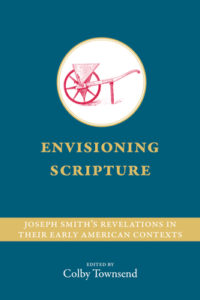 Review
Review
Title: Envisioning Scripture: Joseph Smith’s Revelations in Their Early American Contexts
Editor: Colby Townsend
Publisher: Signature Books
Genre: History, edited volume
Year Published: 2022
Number of Pages: 280
ISBN: 1560854472
Reviewed by Erik Champenois
Envisioning Scripture is a collection of ten essays from scholars on early American religion, with seven of the essays directly dealing with Joseph Smith’s revelations. The volume contextualizes Joseph’s revelations and translations and shows how these scriptural productions parallel and diverge from religious trends of the times.
My favorite essay in the volume is one I’ve read before and is the best thing I have ever read about the Book of Mormon: Jared Hickman’s “The Book of Mormon as Amerindian Apocalypse.” This essay delves deeply into both the racism and anti-racism of the Book of Mormon, arguing that a meta-critical reading of the text challenges and critiques its racist passages. Nephite racism is deconstructed by the Book of Mormon’s “radical racialized apocalypticism” in the latter-day exaltation of the Lamanites, as well as by the voices of Samuel the Lamanite and Jesus, whose prophetic voices critique Nephite self-conceptions. Hickman brilliantly shows how the Book of Mormon’s first-person narrative voices invite us to read the book critically, as a book written and edited by actual authors, rather than as a text literally and transcendentally written by God.
My second favorite essay in the book was Gutjahr’s “The Golden Bible in the Bible’s Golden Age: The Book of Mormon and Antebellum Print Culture.” This chapter contextualizes the Book of Mormon in the Biblical translation and print culture of the time. At a time that Bible translations took great interest in sorting through available biblical manuscripts to arrive at the most accurate renditions possible, the Book of Mormon stood out as a record that declared itself directly translated from original plates and as restoring “plain and precious” truths lost from the extant manuscripts. In relying on genealogies and timelines to show the process of writing the book, the Book of Mormon establishes itself as credible and authoritative in the context of concerns about the accuracy of Biblical translation. The Book of Mormon also self-consciously uses the archaic language of the King James Bible, at a time when some translations had started updating the Bible to a more modern English, and was even deliberately bound in a way to make it look similar to some of the most common editions of the Bible at the time.
Other notable essays include a full assessment of the extent of Joseph Smith’s formal education (likely around seven years, give or take), the challenge of the open canon-nature of the Book of Mormon to traditional Protestant readings of the Bible, and the nature of biblical translation and interpretation in the Stone-Campbell movement. I also found Juster’s “Demagogues or Mystagogues?” interesting in its treatment of gender and prophecy in early America.
A useful collection and recommended reading for anyone interested in better understanding the early American context of Joseph Smith’s revelations.
